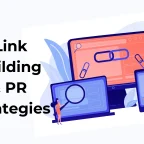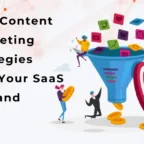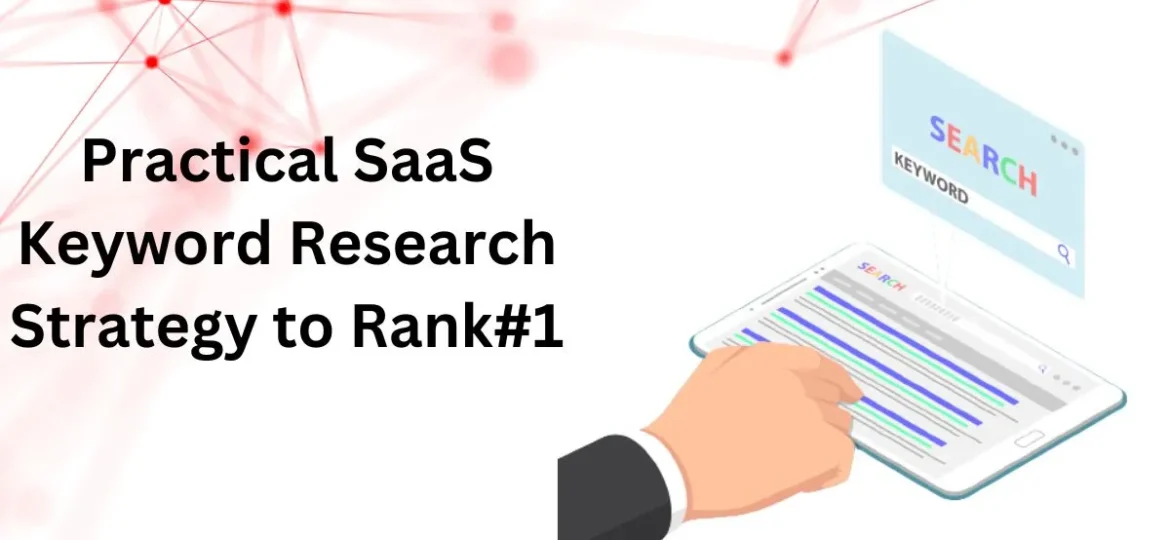An unbelievingly 90% or more searchers haven’t even decided about a brand or product before starting the search process.
Well, this helps us refrain from all such false advice of not considering the keywords with higher difficulty levels or the ones that our top competitors already cover. On top of all, what else can motivate you more than the fact that nearly 70% of the online experience starts with search engines. Thus, keyword research is not all about finding and considering the keyword difficulty (KD), volume, and competitiveness but the customer’s buying intent and how to utilize it to generate leads. This supports the fact that high buying-intent keywords can generate more sales than the ones with higher volume or hundreds of keywords covered by your competitors.
What is SaaS SEO Keyword Research?
Before we get deep into the competitive analysis of the keywords, understanding the keyword research evolution and TOTF & BOTF methods to find the right ones for you— let’s define the SaaS SEO Keyword Research.
“A process of optimizing your SaaS website’s content to get the higher ranking in search engine results for the relevant keywords.”
Acquiring new customers for SaaS business has always been a challenge, and SaaS search engine optimization (SEO) is one of the top methods to fetch some sales. As per stats, SEO is the key to getting way more traffic than any social media channel, and the percentage goes up by 1000%. Therefore, keyword research is all about finding the right phrases or words that potential customers use when searching for software or products of your niche. This will help you in content production and devising the right strategies for your SaaS business to grow rapidly.
Another interesting fact that even most SEO experts are unaware of is that you can rank multiple relevant keywords through a single page. The question arises: how many keywords can a single page rank? Ahref conducted a study of hefty 3M searches and found out that a single ranked page will also appear in the top 10 searches of search engines for 1000 other relevant keywords.
3 Step Approach to Finding Keywords with Higher Conversion Rate
Now that- you have a clear perspective of what SaaS SEO keyword research strategy is, it’s time to devise a strategy of analyzing the competitors and finding the right keywords to take your SaaS website to the top results in SERPs. The process of finding the keywords with conversion rates consists of three basic steps, which are as follows:
1. Brainstorming
Brainstorming keywords for the topics that you target is the seed of your SEO plant. However, be sure not to make the mistake of considering the keywords with low difficulty (KD) or those not covered by the competitors— remember, it’s all about buying intent!
2. Analyzing Search Engine Results Page
Once you have brainstormed the keywords with high-buying intent, the next crucial step is to verify the buying intent by analyzing the search engine results page. The verifying process doesn’t need any software or complex guide to follow. Skim and scan through the top-10 results of Google and analyze the titles, headers, and descriptions to find the buying intent.
Getting confused? Here’s an easy example to understand the complete process. Suppose you search for “Agriculture farming,” and what you’ll get in the search results is a link to Wikipedia, Byjus, and some more scholarly articles that show that buyers are not here to pay for any app or software.
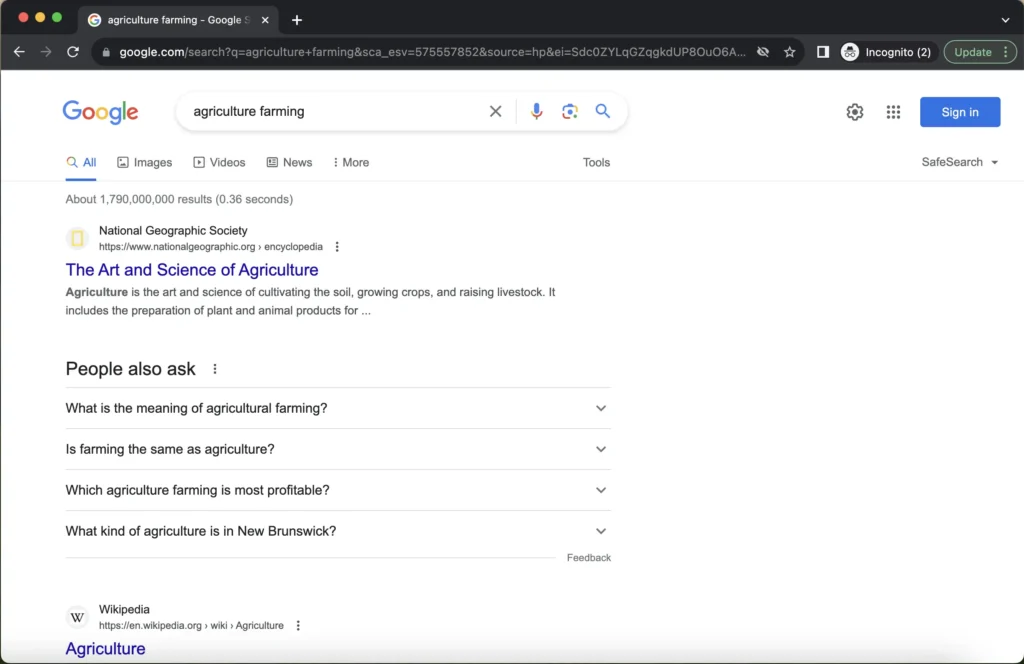
Now, let’s change the keyword to “Agriculture Farming App,” and you’ll get a list of top apps recommended by Google. Here’s a chance to pitch your product on the first page of Google as the keyword clearly shows the buying intent of users.
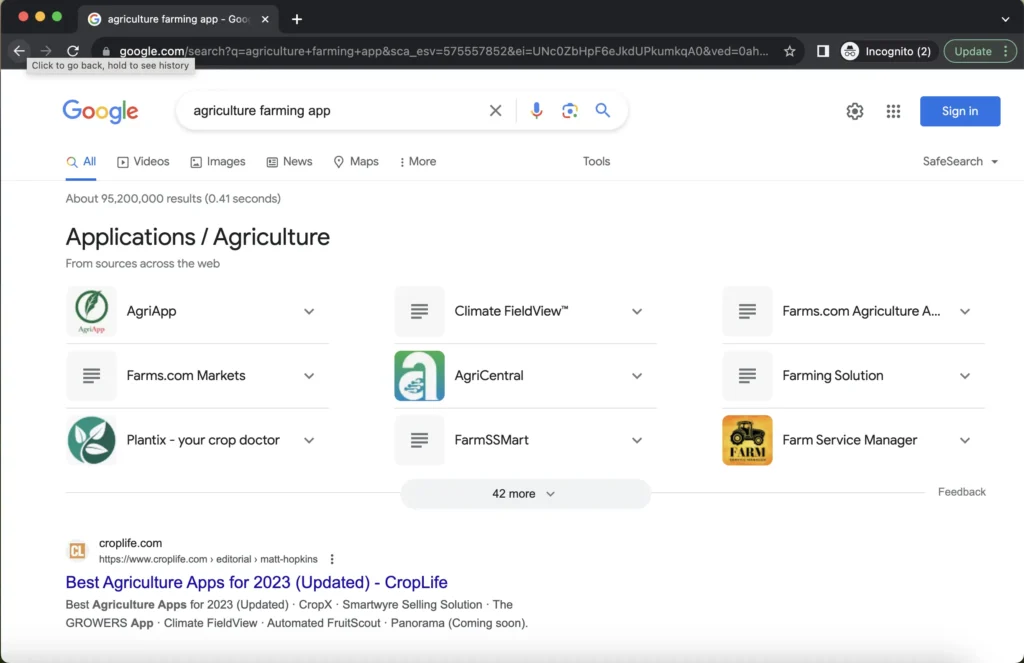
3. Check Keyword Volume and Difficulty Level
As mentioned earlier, analyzing the competitors to find the Keyword Volume and Keyword Difficulty (KD) is not the first but a crucial step. All SEO experts have their own techniques to follow and generate leads. For example, some prioritize the keywords by volume and then focus on the KD and buying intent. This approach aims to fetch more traffic in less time and generate good sales. The other method (recommended) is to focus on the buying-intent keywords first and then move towards the KD or Keyword Volume. Here’s the explanation of why we recommend the second approach.
Buying Intent Over Keyword Volume & KD
Focusing on the buying-intent keywords means you’re trying to rank the keywords that fall under the umbrella of topical authority. Google’s algorithm or approach to find out whether a site is authoritative in a particular niche or not is what we call the Topical Authority. Therefore, our expert SEO team has discovered that topical authority (or focusing on buying-intent keywords) is more productive than keyword difficulty for ranking purposes.
We’ll give an example of a SaaS company focused on time-tracking applications or software. In this niche, the high-volume keywords can be the “productivity tips” or “invoicing clients,” but the topical authority (or buying-intent keywords) will always be the “time tracking apps.”
SaaS Keyword Research Process— A Complete Step-by-Step Guide
From creating effective marketing campaigns to generating sales, keyword research holds the utmost importance in the whole process. There are no hard and fast rules, but some strategies worked better than the rest for the SEO experts, and we’ll look into some of them here. In this guide, a complete SaaS Keyword Research process is explained alongside some of the case studies or examples to follow:
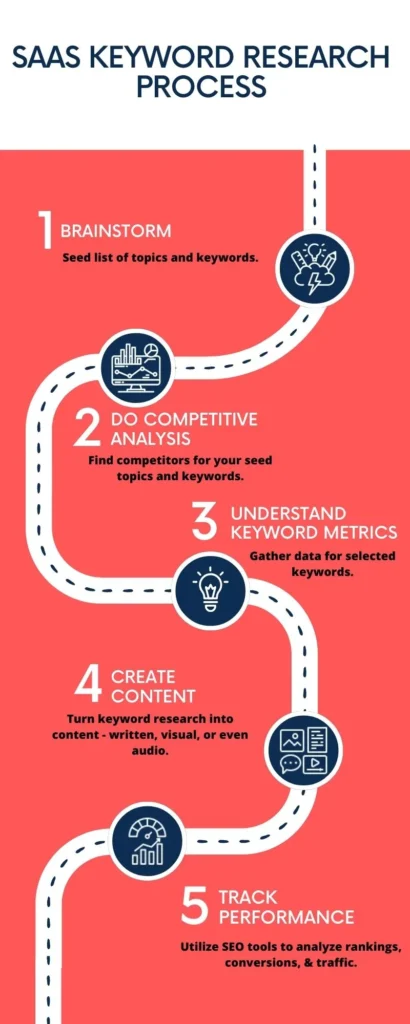
Step 1: Seed List of Topics & Keywords
Before you process brainstorming the keywords and seed topics that are worthy of ranking, it’s essential to understand the audience of your niche or SaaS business. For example, you’re selling tech software for staff scheduling; your targeted areas can range from hotels to hospitals and large-scale workforce organizations that usually face labor shortages. Once you identify the targeted audience, move toward their pain points and the language they utilize for researching their desired software. All this supporting data will help you gather the right keywords.
Identifying the audience and pulling together all the strings will pave the path for our next step, i.e., brainstorming the seed list of topics related to your SaaS business.
Pro tip: Our team of SaaS SEO experts has a pro tip here. Always try brainstorming the seed list of topics and terms with your team members, as it’ll help you gather different perspectives and understand your audience better. You must take the content creation and customer support teams on board, as one will devise and work on new strategies for your software service, and the other will face the end users.
Step 2: Find Competitors for Your Seed Topics and Keywords
You want to rank on the top of search engines in the list, and for that, you’ll need to beat all the other competitors (selling the same or relevant software services), especially those already ranked on your researched seed keywords. This method can also be called “the competitive analysis,” in which you’ll not only find your competitors (manually) but conduct a detailed comparative analysis to find out what’s working for them. There is a 3-step guide for a detailed competitive analysis and how it can help you gather some useful insights from the competitors:
1: Find the Competitor Type— The first step is to find and comprehend the competitor type. Direct competitors offer similar products/software or services, while the indirect ones will have different products but deal with the same keywords or content.
2: Analyzing Strategies— The next step is to analyze the SEO strategies your competitors apply to their websites. This includes finding their top keywords, search volume, keyword difficulty, and multiple other parameters.
3: Filling Gaps— Once you’re done analyzing competitors’ keyword strategy, it’s time to fill some gaps. Find the right opportunity for yourself and dive into that space to fill the space. You can generate content on those particular potential keywords that are not covered by the competitors or improve the content quality for the existing ones.
Step 3: Keyword Difficulty and Search Volume
Now that you have gathered different types of keywords, including the top 10, category, and comparison, In this step, you should gather some data regarding the selected keywords, such as keyword difficulty and search volume at the priority. You can utilize plenty of tools, including the Google Keyword Planner, Ahrefs, Google Trends, AlsoAsked, and more.
To give you an insight into both these terms, here’s an explanation:
Keyword Search Volume: Imagine a keyword is being searched for 100 times in the search engine within a time frame of one month— that’s called the average search volume of that keyword.
Keyword Difficulty: On the other hand, the keyword difficulty, as clear from the name, measures how hard it is to rank a particular keyword on a search engine.
Now, the main question arises: what to prefer and why? There are different perspectives of the specialists on this. However, our research methods prove the buying intent to be more valuable than the volume.
Step 4: Implement the Keyword Research by Turning into Content
The next step is to turn your keyword research into content. In terms of transforming the well-researched keywords into quality content, you’ll have to make a few considerations and choices, and our guide will also shed some light on these. Blogposts might come to mind whenever you think of creating content for a SaaS brand, but that’s just the tip of the iceberg. The content can be in written, visual, or even audio form. Even in the written content, there are a few major types that you can utilize for your SaaS brand:
- Blogposts— The one-of-a-kind and most used type of written content is blogposts, which can be in the form of informative guides and tips articles related to your SaaS product.
- eBooks— eBooks hold the second category and are in-depth and detailed resource material regarding a particular topic or product.
- Infographics— Another source of written, informative content to promote your SaaS services is infographics. It can be the same data in blog posts/articles but in a short visual form for better comprehension.
Once you’ve decided on the type of content, you can employ two further strategies for your SaaS website. If you’ve already started and want to improve things further, you can optimize the existing content; if not, it’s time to create and optimize content simultaneously.
Optimize What You Have: As stated earlier, you can also optimize the already posted content on your SaaS website by utilizing the well-research keywords and incorporating them in the content for better engagement and ranking. You can update the meta description, H2s, H3s, and overall body of the content by adding the targeted keywords.
Create New Content: Creating new content is not just writing words but filling the emotions in your writing by understanding the audience’s needs. Answer users’ queries and present them with a solution to their problems in the shape of your SaaS product.
Step 5: Tracking Performance
The final step is to analyze, observe, and track the performance of your keywords and content. You can utilize different SEO tools to track the performance of your keywords and analyze the rankings, conversions, and overall organic traffic.
- SERPs Rankings— Utilize the smart SEO tools to find out the rankings of your keywords in the search engine. You can also keep an eye on ranking regularly to improve the keywords.
- Organic Traffic – Another essential parameter to track is organic traffic. You can analyze bounce rate, session duration, and more to determine users’ engagement with the posted content.
Final Verdict
Growing a SaaS business is all about finding the correct marketing tactic, and content production is one of them. However, to produce quality content, keyword research is the prior step. Researching superior quality, low difficulty, and high search volume keywords is not just luck but a complete strategy. We hope this guide has helped you understand the key parameters of finding keywords and turning them into quality content for your SaaS website.





